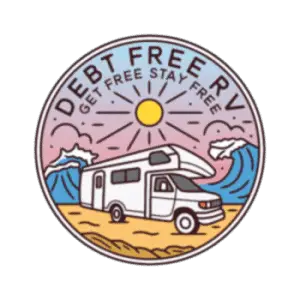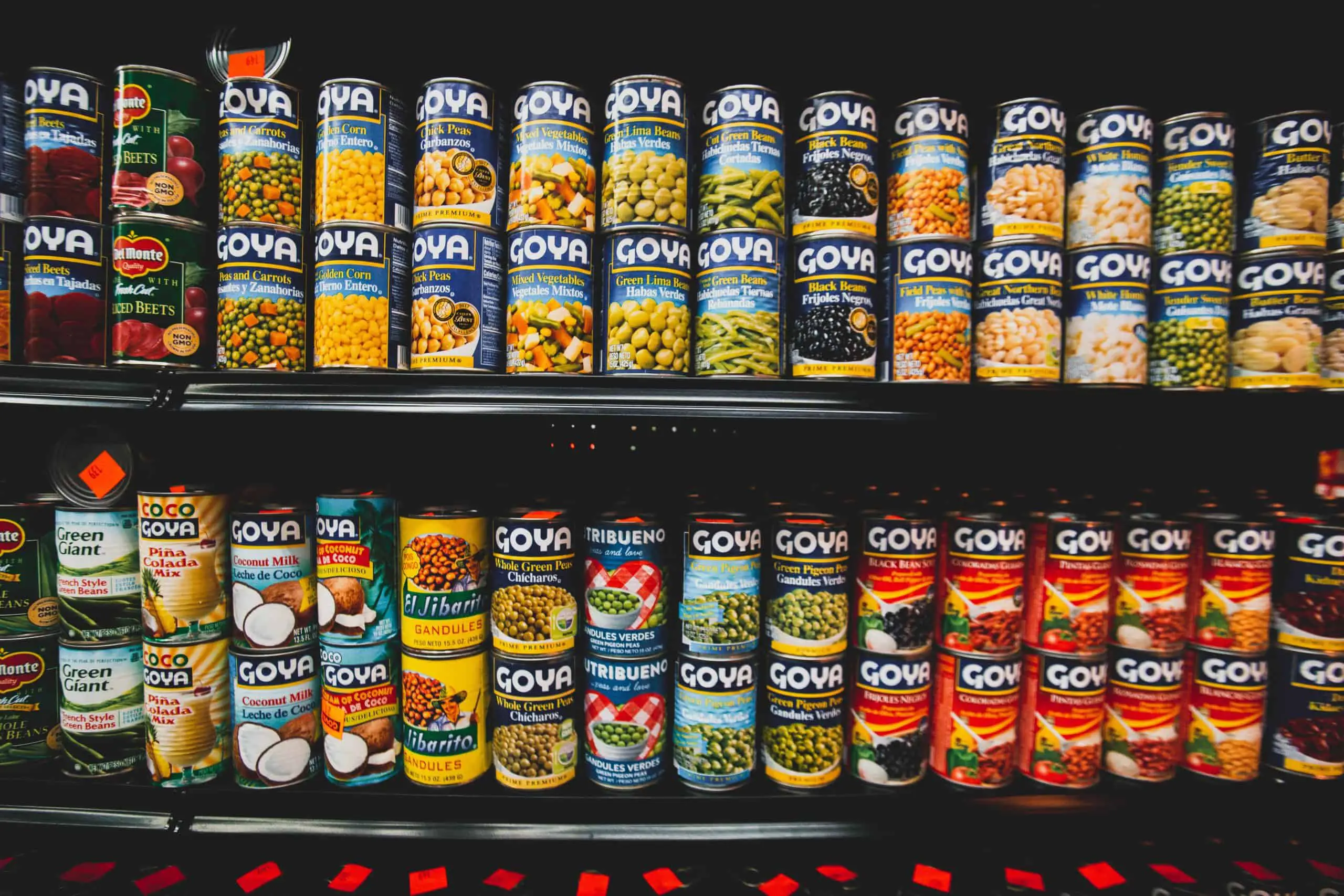Having an emergency food supply stored in your RV is an important, and often overlooked, practice. Living in an RV is liberating: It gives us the ability to travel, explore, and enjoy the outdoors. Because of this la vie boheme, it’s easy for RVers to forget to plan for unexpected emergencies. Making sure to have enough non-perishable food on board is prudent for anyone on the road.
When storing emergency food in an RV, it’s important to consider the following: Limited storage space, weight of food to be stored, how many people need to be sustained during an emergency situation (and for how long), protein, vitamins, and specialty diet options like vegetarian or gluten-free requirements.
Here we’ll discuss some of the best options for emergency food supplies, and what you need to consider before packing up your RV.
Emergency Food in an RV: Space Considerations
Mobility is great, but it comes at a price: Minimal storage space. Even if travelling in a 40′ RV, there is much less usable space than a traditional home.
In an RV, there are a few areas where long-term food storage is possible: Kitchen cabinets, the pantry (if the RV has one), regular cabinets, and under pull-out couch-beds.
When starting your emergency food supply, make as much space as possible: Clear out old, uneaten food, and donate items close to expiration.
Weight Considerations for Stored Food
Keeping an RV and its tires in good shape is essential to the longevity (and safety) of any rig, and part of that maintenance is making sure there’s not too much weight carried.
When it comes to an emergency food supply in an RV, weight is an important consideration. Canned foods like Ravioli, beans, soups, chili, and meats are delicious, simple, and cheap, but if storing too much, they will weigh down a house on wheels.
Instead of filling your RV’s cabinets with only heavy canned foods, let’s unpack the best options for an RVer’s emergency food supply…
Emergency Food Kits: Best Options for RVers
When building up an RV emergency food supply, look for foods that: Have a long shelf-life, are light, compact, nutritious, space-saving, and are easy to cook and eat. The following are some of the types of foods we carry in our own RV, in preparation for the unexpected.
Freeze Dried Fruits and Vegetables (with Recipes)
Having freeze dried fruits and vegetables on-hand, is extremely useful in an emergency. Freeze-drying removes all the moisture from the food, preserving them without needing to worry about mold or expiration before 24-months.
Having a large variety of fruits and vegetables makes it possible to mix-and-match ingredients: If in a long-term emergency situation, having an assortment of flavors is a small, but powerful, boost for morale!

We chose to purchase the Harmony House Foods freeze dried kit for our RV preparedness supply for the following reasons: The pouches are light, varied, easily stored in our “bug-out” bag, and comes with a recipe book complete with directions on how to prepare and cook freeze-dried foods.
This small kit comes with freeze-dried broccoli, carrots, onions, peas… and so much more! The bags are small, but when water is added and the vegetables are cooked, their size increases, and can easily make over 15 single meals.
Basic Dried Necessities
In addition to storing dehydrated fruits and veggies, make sure to include dried kitchen staples to your emergency kit, like:
- Dried Beans (Black, Pinto, Kidney)
- Rolled Oats
- Rice (Basmati, Brown, White)
- Flour
- Baking Powder
- Baking Soda
- Yeast
- Sugar
- Coffee
Having these basic dried necessities ensures you and your family has a wide range of foods to eat during an emergency, and these options are light-weight, easily stored, and have a long shelf life. The chart below shows the average longevity of these basic food supplies:
| Dehydrated Food | Shelf Life |
|---|---|
| Black Beans | 25 Years |
| Brown Rice | 1 Year |
| Cornmeal | 25 Years |
| Macaroni | 20 Years |
| Popcorn | 30 Years |
| Quinoa | 20 Years |
| Rolled Oats | 30 Years |
| Flour | 10 – 15 Years |
| White Rice | 30 Years |
| Yeast | 3 – 5 Years |
| *Coffee, Instant | 2 – 20 Years (depends on seal) |
| *Coffee grounds, Freezer | 1 -3 Years |
| *Coffee Whole Bean, Freezer | 2 -3 Years |
30-Day Food Supply Kit
Compact and easy to use, having a 30-day emergency kit stored lifts the stress of having to plan and prepare individual ingredients for meals while in less-than-optimal situations.
The Augason 30-Day Emergency Food Supply kit is one of the most popular on the market, and for good reason: One tub contains a 30-day supply of food for one person. Within the kit, each meal comes in a separate, air-tight package, requiring only the addition of water and heat.
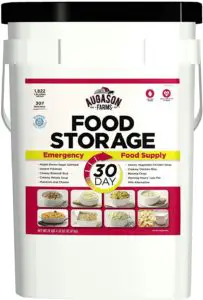
Each kit weighs 20 pounds, and contains delicious meals ready to go, like: Buttermilk pancakes, Chicken Alfredo, Spanish Rice, and Potato Soup. The expected rations equal 1200 calories daily; For those of us who need a little help stretching out the kit for the full 30-days, the Augason company kindly includes a 30-Day Meal Planner, taking out the guesswork of sustaining a month-long emergency situation.
Ration Food Bars
Food ration bars are tightly sealed, long-lasting, compact, and very light. However, they typically aren’t the most healthy choice. High in carbs and sugars, while low on protein, food ration bars are created to provide energy and sustain, not to fill you up.
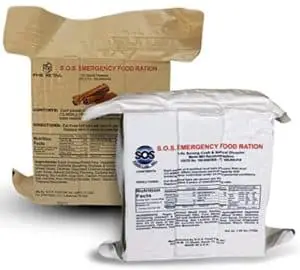
We have one package of the S.O.S Emergency Food Rations in our RV pantry for a few reasons due to their super-compact packaging, their longevity (up to 25-year shelf life), and also their taste! Surprisingly sweet and cinnamon-y, these taste a bit like cookies. Don’t expect these to fill you up in an emergency, but they can give you a bit of energy, and can also serve as a type of dessert during tough times.
Protein Bars
Protein bars are a great addition to have in any emergency kit, as they’re small, more filling than a traditional ration bar, and normally taste better!
Unlike ration bars, which come in just a few flavors, protein bars have a huge variety of delicious tastes, from: Chocolate Mint, Cookie Dough, Chocolate Raspberry, Peanut Butter, Lemon… They’re great tasting snacks to have on hand.
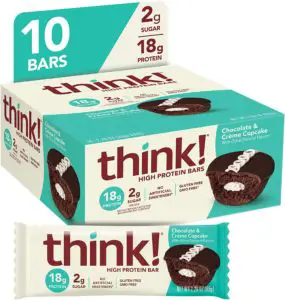
Just make sure to read the labels of protein bars: Many still have higher sugar content, which tastes good initially, but does not satiate in the long-term. When blood sugar spikes- even if it’s due to a protein bar- energy drops and hunger isn’t too far behind. Which brings us to…
Nuts: High Protein, High Fat
High fat content slows the rate of sugar absorption, and protein satiates, so having something that fits the bill is a must-have for an emergency food supply.
Peanut Butter is a staple of emergency pantries (low or no-sugar peanut butter to combat a sugar rush and following hunger pangs). Plain or lightly salted nuts like peanuts, almonds, pistachios, and cashews are light-weight, take up little space, and have a relatively long shelf life (ranging from six months to two years, depending if they’re kept at room temperature, in the fridge, or in the freezer).
Often, nuts are on the expensive side, but just eating a handful or two can go a long way to feeling full, and providing much needed energy.
Powdered Proteins
Protein powders can be a life saver: With the addition of water, milk, or a non-dairy alternative, a low-sugar, high protein, high-vitamin-containing powder satiates without being too heavy.
And there are tons of protein powders on the market, from: Whey proteins, to Keto, and even vegan options.

We keep Amazing Grass Protein Super Food powder in our emergency kit, as it’s not only filling, but contains two servings of fruits and veggies in every serving. The powder provides vitamins and minerals, and the flavor is great! And one tub goes a long way: One 15 ounce container provides roughly 10 (liquid) meals.
Vegetarian and Gluten-Free Emergency Food Options
Emergency food kit companies take specialty diets into consideration, so for those who are vegan, vegetarian, or gluten-free, there are some choices on the market.
Pre-made vegan/vegetarian meals are available, however, one major disadvantage is that most are high carbs; Great for quick energy, but without added fat or protein, expect a blood-sugar crash after eating.
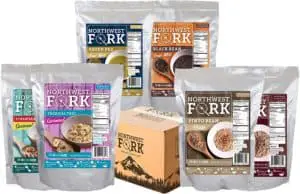
Considering the high carb drawback of these specialty diet options, it’s a good idea to have additional proteins and fats to help balance out any spikes in blood sugar, such as: Adding peanut butter to oatmeal, adding (powdered) eggs to rice meals, or enjoying a high-protein powder drink with a meal.
Always Have Water
Without water, the human body can only survive three to five days. Symptoms of dehydration include: Extreme thirst, sweating, sluggishness, fainting, and eventual organ failure followed by death. So forgetting to store up some extra water is out of the question.
Emergency water packs are an essential addition to your emergency food supply, as they’re pre-rationed, have a long shelf life, and are easily carried.
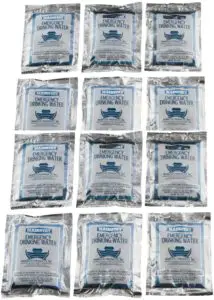
Don’t Forget Seasonings
Rice and beans might keep you alive during an emergency, but without seasonings, the brain gets bored. So, make sure to have at least a basic seasoning kit stored: Salt adds some flavor to food but also provides electrolytes! Cinnamon can make oatmeal more tasty and enjoyable. Hot pepper flakes kicks up run-of-the-mill mac n’ cheese.

Seasonings might seem like a small consideration for emergency preparedness, but if the situation lasts longer than expected, and you’re staring at another plain bowl of rolled oats, it’s highly likely you’ll regret not having any extra seasonings in your kit.
Final Thoughts
Living in an RV means space is limited, so storing an emergency food supply can prove difficult. In order to store extra food, make sure to clean out any expired foods, and donate foods close to expiration.
Use available cabinet areas, and empty space under the foldout couch/bed to store dried goods, and pre-made emergency tubs.
Have high protein, high fat options available, while also including a good supply of dehydrated fruits, vegetables, and water.
In an emergency situation, food and water may not be enough. Emergency kits, pet supplies, and bug out bags are important, so make sure to check out the next post, “Emergency Kits for Camping (And What You MUST Have Inside” here.
